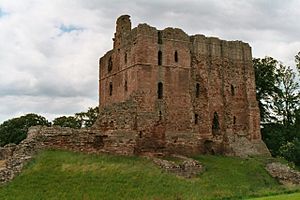Thomas Grey (chronicler) facts for kids
Quick facts for kids
Sir Thomas Grey
|
|
|---|---|

Norham Castle
|
|
| Died | before 22 October 1369 |
| Spouse(s) | Margaret de Presfen (Pressene) |
| Children | Sir Thomas Grey Elizabeth Grey Agnes Grey |
| Parent(s) | Sir Thomas Grey Agnes de Bayles |
Sir Thomas Grey (died before 22 October 1369) was a brave knight from Heaton Castle in Northumberland, England. He was the son of another famous soldier, also named Sir Thomas Grey. Our Sir Thomas Grey is best known for writing an important history book called the Scalacronica. This book tells the story of England and the world from ancient times.
Contents
Sir Thomas Grey's Life and Legacy
Sir Thomas Grey lived during a time when England and Scotland often fought. He was a knight who served his king, Edward III, in many battles and important roles.
His Family and Early Life
Sir Thomas Grey's father, also named Thomas Grey, was a very important soldier. He fought for King Edward I and King Edward II against the Scots for many years. Once, in 1297, his father was badly hurt in a fight with William Wallace but he got better. He was also captured by the Scots in 1303 and again in 1314.
Sir Thomas Grey had four sisters. They married into important families of the time. His father was in charge of Norham Castle from 1319 to 1331. This castle was very important for defending the border with Scotland.
Becoming a Knight and Serving the King
Sir Thomas Grey became a knight before his father passed away. He likely fought alongside his father in Scotland in the 1330s. His first experience in war might have been in 1332. This was when a group of noblemen, called the "Disinherited," went into Scotland and won a battle at Dupplin Moor.
In 1338, Sir Thomas Grey joined a military trip to Flanders (modern-day Belgium). He also served on the border with Scotland, known as the Scottish Marches, in 1340.
Important Roles and Building Heaton Castle
Because of his good service, King Edward III gave Sir Thomas Grey important jobs. In 1344, he became the warden (manager) of a large area of land called Middlemast Middleton. A year later, in 1345, he was made the Constable (commander) of Norham Castle. This was the same castle his father had commanded.
Sir Thomas Grey also gained a lot more land during his life. He likely built Heaton Castle, making his family's estate much better than it was before.
Captured by the Scots
In 1346, Sir Thomas Grey fought bravely at the Battle of Neville's Cross. King Edward III even sent him a personal thank you letter!
However, in 1355, something difficult happened. While leaving Norham Castle, Sir Thomas Grey and one of his sons were surprised and captured by the Scots at Nesbit. He was held prisoner at Edinburgh Castle. He wrote to King Edward III, asking for help to pay the money needed for his release, called a ransom. He was finally set free by 1357.
Later, in 1359, Sir Thomas Grey might have traveled to France with King Edward's oldest son, Edward, the Black Prince. In 1367, he was made the Warden of the East Marches. This was a very important job, overseeing the eastern border with Scotland. Sir Thomas Grey passed away sometime before October 1369.
His Famous Book: The Scalacronica
While he was held captive in Edinburgh Castle, Sir Thomas Grey started writing his famous book, the Scalacronica. This book is a chronicle, which means it's a historical record of events. He wrote it in a language called Anglo-Norman French.
The Scalacronica tells the history of the world and England from the very beginning. Sir Thomas Grey was released in 1356, but he kept working on his book until 1362. The most valuable parts of his book are those that describe the reigns of King Edward I, King Edward II, and King Edward III. This is because he and his father were both soldiers in the wars against Scotland and France during these times. They had personal experiences that made their accounts very accurate and important for historians today.
His Marriage and Children
Around 1353, Sir Thomas Grey married Margaret de Presson. She was the daughter and heir of William de Presson from Northumberland. They had at least one son and three daughters:
- Ivetta Grey (born 1350)
- Sir Thomas Grey (1359 – 26 November 1400), who also became a knight and married Joan de Mowbray.
- Elizabeth Grey (died 11 August 1412), who married Philip Darcy, 4th Lord Darcy of Knaith.
- Agnes Grey (died 25 October 1420), who married Sir Thomas Umfraville.

